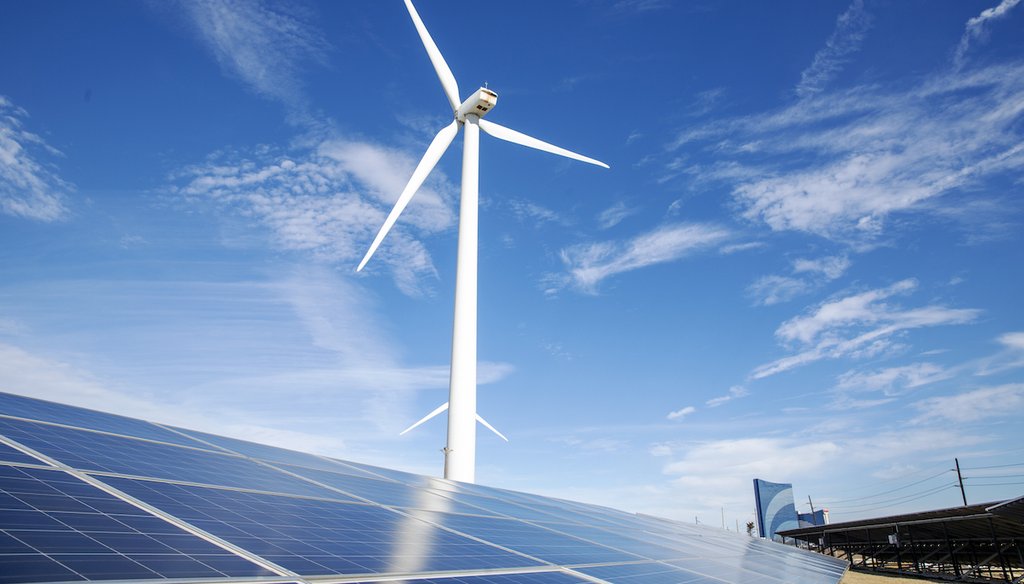Get PolitiFact in your inbox.

Wind turbines spin to generate electricity above solar panels in Atlantic City, New Jersey, in this 2021 file photo. (AP)
If Your Time is short
-
Virtual power plants let ordinary people band together to tap, store and aggregate electricity from their electric cars, rooftop solar panels and smart thermostats.
-
The electricity can be held for later use, such as when grids reach peak capacity and need extra supply. It also can be gathered through aggregators and sold to traditional power companies.
-
Virtual power plants are saving money for consumers and utility companies, providing additional electricity and helping reduce emissions.
With a warming climate boosting demand for electricity, virtual power plants might give consumers power to help ease the burden.
Virtual power plants, or VPPs, allow ordinary people to band together to tap, store and aggregate energy from rooftop solar panels, electric vehicles and smart thermostats. Homes and businesses that participate in VPPs can lower bills and receive direct compensation by selling power back to utility companies.
The estimated 500 virtual power plants operating in the U.S. provide electricity on a small scale. But their growing numbers are saving money for consumers and power plants, providing additional electricity when the overtaxed grid most needs it and helping reduce emissions that cause climate change.
"We’re using our smarts to change the way the system can operate in a way that doesn’t affect users in any measurable way but really does help the system," said California climate researcher and former Stanford University lecturer Jonathan Koomey.
"The insight that saving energy can be as useful to the system as generating it goes back to the ’70s. Now, because of computer technology, we’re able to implement that on a much grander scale."
Rachel Marcus, principal analyst at global research and consulting group Wood Mackenzie, said most VPPs were created in the last couple of years, but "we’re at a point where there are very successful pilots. This is a reliable resource."
A virtual power plant takes up no physical space; it’s based in the cloud, a system of hard drives, computer servers, signal routers and fiber-optic cables.
A VPP can draw from large-scale resources, such as wind farms, or small ones, such as a homeowner’s rooftop solar system.
"The really appealing aspect of VPPs is customers are buying smart thermostats and electric vehicles for reasons that have nothing to do with participating in a virtual power plant program," said Ryan Hledik, principal at The Brattle Group, a Boston-based business consulting company. "We’re getting better utilization of assets that have already been deployed, rather than having to go out and build a new power plant."
Virtual power plants are on the increase as solar power adoption continues to rise. About 3.4% of electricity in the U.S. is generated by solar. Solar produced 146 billion kilowatthours of electricity in 2022, up from 4 billion in 2012. (One kilowatt-hour keeps one 1,000-watt appliance running for one hour.)
Koomey said virtual power plants also are aided by the growing number of home battery storage systems, which have been boosted by a 30% federal tax credit provided in the 2022 Inflation Reduction Act.
The federal government is also backing the effort.
In April, the Energy Department announced its first loan guarantee for a virtual power plant project, worth $3 billion, to Sunnova Energy International, a Houston-based solar energy company. The project aims to provide solar energy through virtual power plants to about 100,000 homeowners throughout the U.S.
While relatively new as a power source, virtual power plants have been shown to be a viable option.
-
A May report for Google by The Brattle Group said VPPs have the potential to rival the reliability of traditional power grids. They could also save U.S. utilities $15 billion to $35 billion over 10 years in investments in traditional power generation.
-
A study by Vermont Law and Graduate School researchers that examined three VPPs — in Vermont, California and Australia — concluded that VPPs are "a clean, flexible and resilient resource that can support the clean energy transition."
-
A virtual power plant based on energy stored from Tesla batteries and Nest thermostats helped California avoid rolling power outages in summer 2022.
Virtual power plants reduced more than 1.8 gigawatt hours of energy demand over the summer of 2023 among customers of ISO New England, said Mark Dyson, managing director of carbon-free electricity at the Rocky Mountain Institute, a Denver-based environmental nonprofit focused on energy use and production.
One gigawatt of power is enough to power about 750,000 homes.
Dyson said virtual power plants could help reduce annual spending on power by $17 billion by 2030.
The "real value is big cost savings," said Kevin Jones, director of the Vermont Law and Graduate School Institute for Energy and the Environment. But the plants also are environmentally friendly because older, more polluting power plants can be retired.
To that point, research shows virtual power plants can offer additional capacity during peak electricity demand and help replace "peaker plants," facilities deployed only when power grids cannot keep up with energy demands. Peaker plants run on fossil fuels, particularly natural gas, and emit carbon dioxide that can worsen climate change.
Peaker plants are "the dirtiest resources on the grid," said Marcus, the Wood Mackenzie analyst. "The goal is putting peaker power plants out of business and that should have a huge impact for climate change."
Koomey said that even on a relatively small scale, tapping virtual power plants when traditional power plants are operating at peak capacity is crucial because that’s when the power grid is at greatest risk of failing and the price of power is at its highest.
Some utility companies have partnered with solar companies to create virtual power plants serving thousands of homes. They include Rocky Mountain Power, which serves parts of Utah, Idaho and Wyoming, Green Mountain Power in Vermont and Pacific Gas and Electric in California.
In January, led by the Rocky Mountain Institute, the Virtual Power Plant Partnership formed with founding members that include Ford Motor Co., General Motors Co., solar energy companies SunPower and Sunrun, and smart electrical panel maker SPAN. The partnership seeks to shape policies and regulations to expand the VPP market.
On July 26, the California Energy Commission approved expanding incentives for more VPPs.
While some support exists, Hledik and Marcus said a major challenge to developing more virtual power plants is gaining additional support from traditional utility companies.
"Some utilities are just going to try and wait as long as they possibly can until they are forced to do these types of programs," Marcus said.
Hledik said utilities need financial incentives to promote VPPs.
Utility companies "earn a return on investing in the power grid," he said. "They typically don’t earn that same return if they go out and find customers for a virtual power plant program."
RELATED: Red light on ‘greenwashing’? US regulatory agency takes fresh look at deceptive climate claims
RELATED: Clean slate? ‘Carbon capture’ of CO2 emissions seen as technology that’s a climate solution and risk
RELATED: What role does natural gas play in a ‘clean energy’ future? Separating spin from science in TV ads
RELATED: New electric vehicle tax credit rules aim to reduce dependence on China, but present new obstacles
RELATED: Billions of dollars are being invested in pricey ‘green’ hydrogen. Is it a viable climate solution?
Our Sources
Inside Climate News, "Virtual Power Plants Are Coming to Save the Grid, Sooner Than You Might Think," June 22, 2023
Reuters, "Explainer: What is a virtual power plant?", Jan. 31, 2023
Energy Department, "LPO Offers First Conditional Commitment for a Virtual Power Plant to Sunnova’s Project Hestia to Support Grid Reliability and Expand Clean Energy Access," April 20, 2023
Washington Post, "Electric vehicles can now power your home for three days," posted Feb. 7, 2023; updated Feb. 17, 2023
San Diego Gas & Electric Co., "Energy 101: Virtual Power Plants, Explained," Feb. 16, 2022
Green Mountain Power, "GMP Requests Removal of Cap on Powerwall and BYOD Home Battery Programs to Expand Customer Access to Cost-Effective Backup Power," April 26, 2023
Senate, H. R. 5376 (Section 13302), accessed July 28, 2023
The Brattle Group, "Real Reliability: The Value of Virtual Power," May 2023
Sunrun, "Sunrun and PG&E Collaborate on Residential Battery-Powered Virtual Power Plant to Support Grid Reliability for Electric Customers," Feb. 6, 2023
San Diego Journal Of Climate & Energy Law, "How Virtual Powers Plants Can Advance Electrification and Mitigate Infrastructure Needs As We Race to Meet Our Climate Challenges," 2022"
Interview, Ryan Hledik, San Francisco- and London-based principal at The Brattle Group, July 13, 2023
Interview, Kevin Jones, director of the Institute for Energy and the Environment and professor of energy technology and policy at Vermont Law and Graduate School, July 14, 2023
Interview, Rachel Marcus, principal analyst, Grid Edge, at Wood Mackenzie, July 17, 2023
Houston Chronicle, "Tesla says its Powerwall electricity customers can be paid to send power to the grid," July 21, 2023
Interview, California climate researcher and former Stanford University lecturer Jonathan Koomey, July 28, 2023
Solar Power World, "California Energy Commission approves new statewide VPP program," July 27, 2023
California Energy Commission, "July 26, 2023, Business Meeting Backup Materials for Agenda Item No 05: Demand Side Grid Support (DSGS) Program – 22-RENEW-01," accessed July 28, 2023
Email, Mark Dyson, managing director of carbon-free electricity, Rocky Mountain Institute, a Denver-based environmental nonprofit that focuses on the production and use of energy, July 28, 2023






















